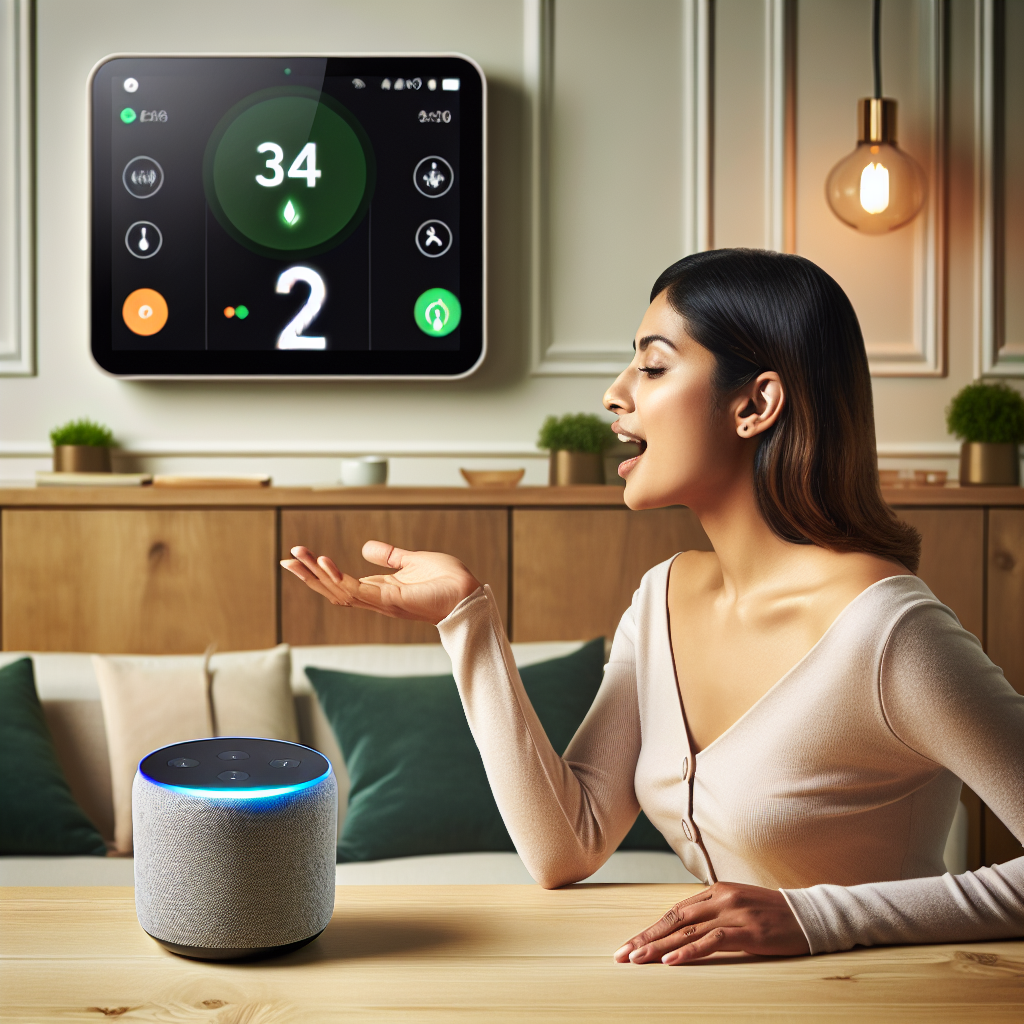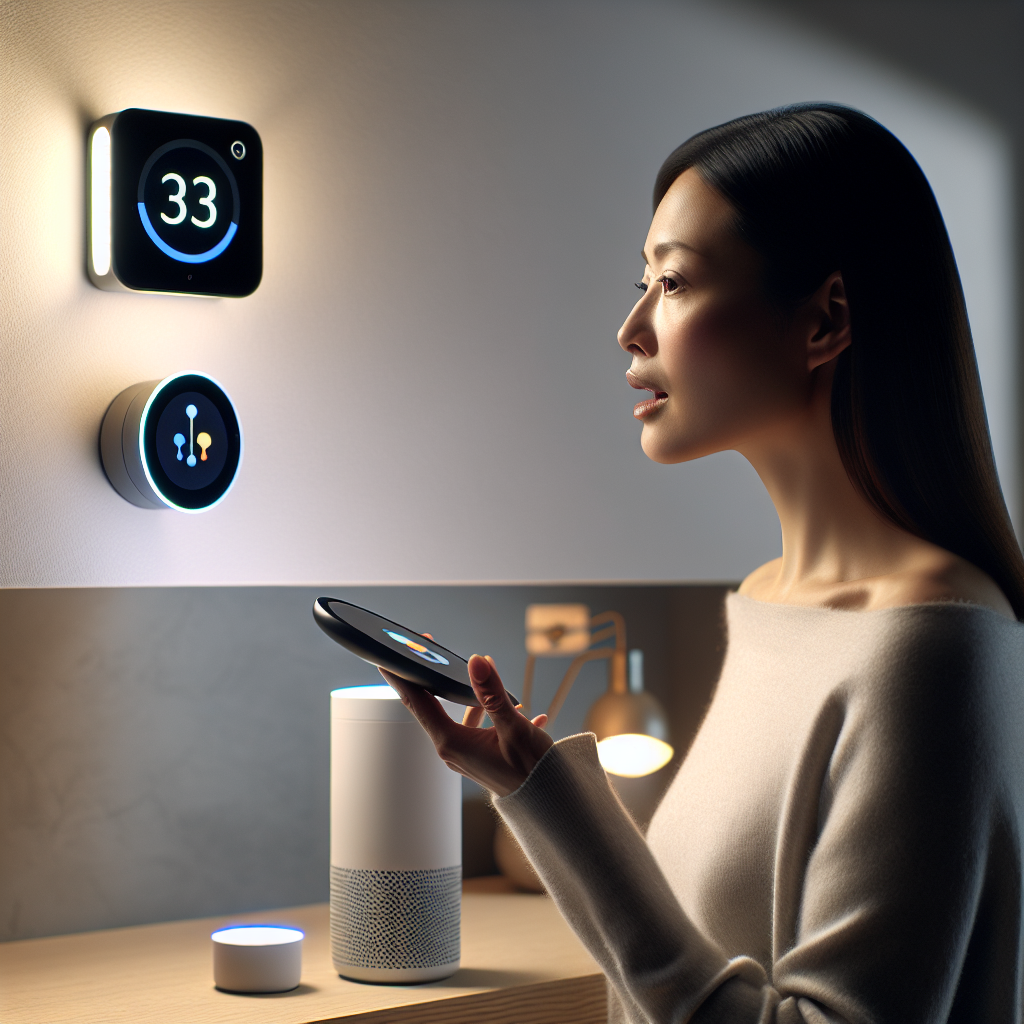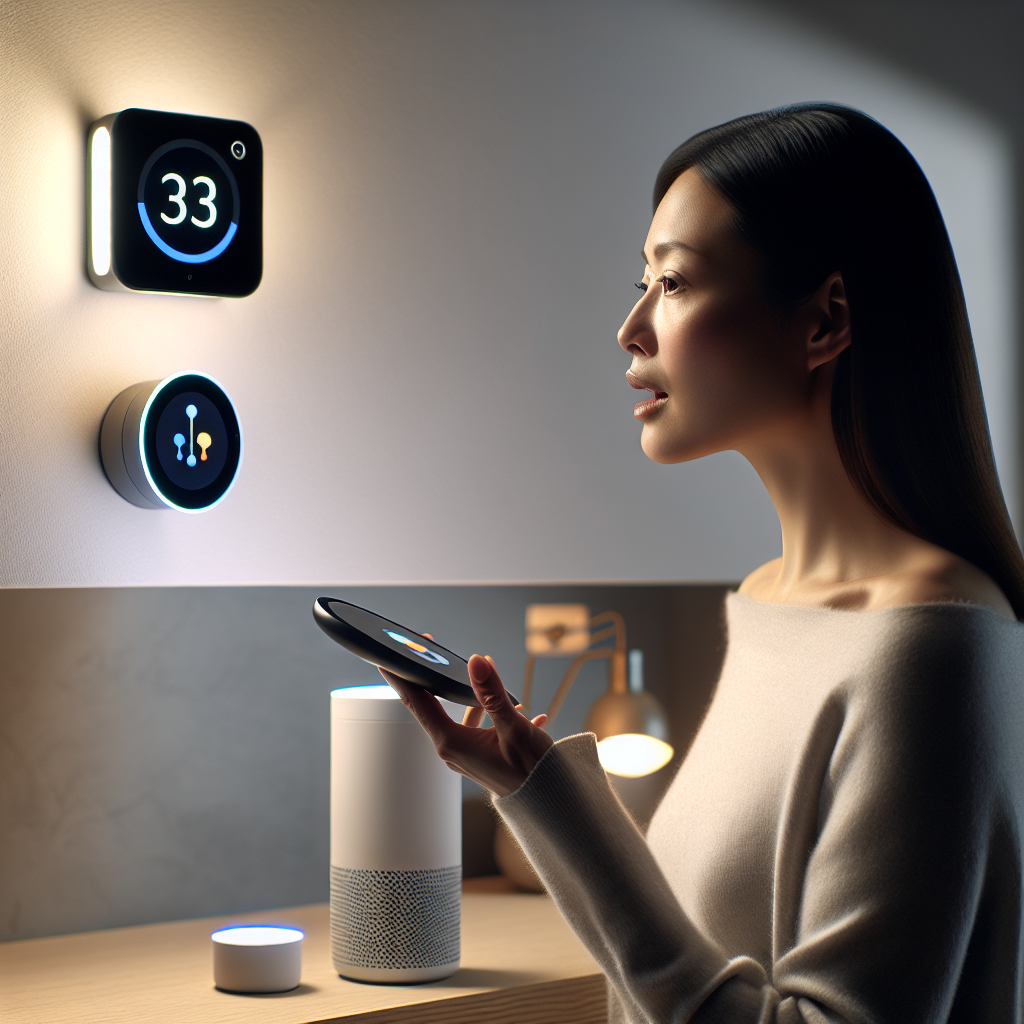Have you ever wondered if you can control your smart thermostat with simple voice commands and virtual assistants? Well, the answer is a resounding yes! With advancements in technology, it is now easier than ever to have complete control over your home’s temperature using just your voice. By integrating your smart thermostat with popular virtual assistants like Alexa and Google Assistant, you can effortlessly adjust the temperature, set schedules, and even create custom commands to make your home environment more comfortable and energy-efficient. Say goodbye to manual adjustments and hello to the convenience of voice-activated comfort!

Benefits of Controlling Smart Thermostats with Voice Commands and Virtual Assistants
Convenience and Hands-Free Operation
Controlling your smart thermostat with voice commands and virtual assistants offers unparalleled convenience and hands-free operation. Instead of manually adjusting the temperature settings or fumbling with buttons, you can simply speak commands to your virtual assistant, allowing you to control the thermostat from anywhere in your home. This means you can easily change the temperature while cooking in the kitchen, relaxing in the living room, or even lying in bed. The ability to control your thermostat without lifting a finger adds a new level of convenience to your daily routine.
Efficient Energy Management
One of the key benefits of using voice commands and virtual assistants to control your smart thermostat is efficient energy management. By being able to adjust your thermostat settings with ease, you can optimize your energy usage and save on utility costs. For example, if you realize you forgot to turn off the heating or cooling when leaving the house, you can simply use your virtual assistant to remotely access the thermostat and make the necessary adjustments. Additionally, some smart thermostats have the ability to learn your daily routine and make automatic temperature adjustments accordingly, further enhancing energy efficiency.
Integration with Other Smart Home Devices
Another advantage of controlling your smart thermostat with voice commands and virtual assistants is the seamless integration with other smart home devices. Many virtual assistants, such as Amazon Alexa, Google Assistant, Apple Siri, and Microsoft Cortana, have the ability to connect and communicate with a wide range of smart devices. This means you can create a cohesive smart home ecosystem where your thermostat works in harmony with other devices, such as smart lights, speakers, and security systems. For example, you can set up a voice command to dim the lights and adjust the temperature simultaneously, creating a personalized and convenient home environment.
Personalization and Customization
Controlling your smart thermostat with voice commands and virtual assistants allows for a high level of personalization and customization. You can easily tailor the thermostat settings to suit your preferences and comfort. Whether you prefer a specific temperature or have unique heating and cooling needs, voice control makes it easy to make adjustments on the fly. Additionally, some smart thermostats offer personalized settings based on individual user profiles, allowing each member of the household to have their own temperature preferences. This level of personalization ensures everyone in the household can enjoy a comfortable living environment.
Enhanced Accessibility and User Experience
Voice control provides enhanced accessibility and user experience for individuals with physical disabilities or mobility limitations. For those who may have difficulty operating traditional thermostats or accessing physical buttons, voice commands offer a convenient and accessible alternative. With just a simple voice command, individuals can easily adjust the temperature settings without the need for physical interaction. This enhances independence and improves the overall user experience for individuals with disabilities, making it easier for them to maintain a comfortable living environment.
Compatibility with Popular Virtual Assistants
Smart thermostats are compatible with a variety of popular virtual assistants, each with its own unique features and capabilities. Here are the most popular virtual assistants and their compatibility with smart thermostats:
Amazon Alexa
Amazon Alexa is one of the most widely used virtual assistants and is highly compatible with smart thermostats. You can easily connect your smart thermostat to Alexa-enabled devices, such as the Amazon Echo or Echo Dot, and control the thermostat using voice commands. Alexa offers a wide range of functionalities, including adjusting the temperature, setting schedules, and even integrating with other smart devices in your home.
Google Assistant
Google Assistant is another popular virtual assistant that seamlessly integrates with smart thermostats. By connecting your smart thermostat to Google Assistant-enabled devices, such as Google Nest speakers or Android smartphones, you can control the thermostat through voice commands. Google Assistant offers various features, such as adjusting the temperature, setting routines, and providing real-time information about your thermostat’s status.
Apple Siri
If you’re an Apple user, you can control your smart thermostat using Apple Siri, the virtual assistant available on iPhones, iPads, and Apple Watches. By connecting your smart thermostat to Apple’s Home app, you can use Siri to adjust the temperature settings, create scenes, and even control your thermostat remotely through Apple’s HomeKit platform.
Microsoft Cortana
For Windows users, Microsoft Cortana offers voice control capabilities for smart thermostats. By connecting your smart thermostat to a Windows PC or a compatible Cortana-enabled device, you can use voice commands to adjust the temperature, set schedules, and integrate with other smart devices in your home. Cortana provides a hands-free experience, allowing you to control your thermostat without the need for physical interaction.

Setting Up and Configuring a Smart Thermostat for Voice Control
To control your smart thermostat with voice commands, you need to follow a few simple steps to set up and configure the system correctly.
Choosing a Compatible Smart Thermostat
First, you’ll need to choose a smart thermostat that is compatible with the virtual assistant you plan to use. Check the manufacturer’s specifications to ensure compatibility with your chosen virtual assistant, whether it’s Amazon Alexa, Google Assistant, Apple Siri, or Microsoft Cortana. Different thermostats have different integration options, so make sure to select a model that supports the virtual assistant you prefer.
Connecting the Smart Thermostat to a Virtual Assistant
Once you have your smart thermostat, you’ll need to connect it to your virtual assistant. This typically involves installing the virtual assistant’s app on your smartphone or device and following the setup instructions provided. You may also need to enable the skill or action specific to your smart thermostat brand.
During the connection process, you may be required to enter your smart thermostat’s unique identification code or connect it to your Wi-Fi network. Follow the prompts provided by the virtual assistant to complete the setup process.
Configuring Voice Commands and Preferences
After connecting your smart thermostat to the virtual assistant, you can start configuring voice commands and preferences. Some virtual assistant apps have built-in features that allow you to customize the voice commands you want to use. For example, you can set a specific phrase to adjust the temperature or create a routine that triggers certain actions when you say a particular command.
Take the time to explore the settings and options within the virtual assistant’s app to customize the voice commands and preferences according to your needs. This will ensure a seamless and personalized experience when controlling your smart thermostat with voice commands.
Basic Voice Commands for Smart Thermostat Control
Once your smart thermostat is set up and configured for voice control, you can start using a variety of basic voice commands to control its functions. Here are some common voice commands for smart thermostat control:
Adjusting Temperature Settings
To adjust the temperature settings on your smart thermostat, simply use voice commands like “Set the temperature to 72 degrees” or “Increase the temperature by 2 degrees.” The virtual assistant will relay your command to the thermostat, and the temperature will be adjusted accordingly.
Changing Operating Modes
You can also use voice commands to change the operating modes of your smart thermostat. For example, you can say “Switch to cooling mode” or “Change to heating mode” to switch between different temperature settings based on your preferences and seasonal needs.
Setting Heating and Cooling Schedules
Another useful voice command feature is the ability to set heating and cooling schedules. Simply say “Create a schedule for weekdays” or “Set a temperature schedule for the weekend,” and your smart thermostat will adjust the temperature settings automatically according to the specified days and times.
Checking Current Indoor Temperature
If you want to know the current indoor temperature, you can ask your virtual assistant using voice commands like “What is the current temperature?” or “Check the temperature indoors.” The virtual assistant will provide you with the real-time temperature reading from your smart thermostat.
Turning On/Off the Thermostat
To turn your smart thermostat on or off using voice commands, you can simply say “Turn on the thermostat” or “Turn off the thermostat.” This feature is particularly useful when you’re leaving the house or want to conserve energy when the thermostat is not in use.
Activating Energy Saving Features
Many smart thermostats offer energy-saving features, and you can activate them using voice commands. For example, you can say “Enable energy-saving mode” or “Activate eco-mode” to optimize energy usage and reduce utility costs.

Advanced Voice Commands and Features
Beyond the basic voice commands, smart thermostats offer a range of advanced voice commands and features that further enhance their functionality. Here are some examples:
Zoning Control for Multiple Rooms
Some smart thermostats support zoning control, allowing you to set different temperature settings for each room or zone in your home. With voice commands like “Adjust the temperature in the living room to 70 degrees” or “Increase the temperature in the bedroom,” you can individually control the temperature in specific areas of your home.
Adjusting Fan Speed and Airflow
If your smart thermostat is equipped with fan control, you can use voice commands to adjust the fan speed and airflow. For example, you can say “Increase fan speed to high” or “Change fan mode to circulating” to customize the cooling or heating experience to your liking.
Controlling Humidity Levels
Some smart thermostats have built-in humidity sensors and control features. By using voice commands like “Increase humidity to 50%” or “Lower humidity levels,” you can maintain optimal humidity levels in your home for improved comfort and air quality.
Integrating with Smart Home Routines and Automations
Smart thermostats can be integrated into your existing smart home routines and automations. For instance, you can create a routine that triggers certain temperature settings when you say a specific command or when other smart devices are activated. This integration allows for seamless control and customization of your home environment.
Monitoring and Analyzing Energy Usage
Many smart thermostats provide insights and data regarding your energy usage. By asking your virtual assistant questions such as “What is my energy consumption for this month?” or “How much am I spending on heating?” you can monitor and analyze your energy usage patterns, helping you make informed decisions to optimize energy efficiency.
Receiving Energy Efficiency Tips and Recommendations
Some smart thermostats provide personalized energy efficiency tips and recommendations based on your usage patterns. By asking questions like “How can I reduce my energy consumption?” or “What are some energy-saving tips?” you can receive valuable suggestions and insights to help you conserve energy and save money.
Voice-Assisted Thermostat Control: Tips and Best Practices
To make the most out of controlling your smart thermostat with voice commands, consider the following tips and best practices:
Using Clear and Specific Voice Commands
When giving voice commands to your virtual assistant, it’s important to be clear and specific. Use concise and straightforward phrases that clearly convey your intent. This will minimize the chances of miscommunication and ensure that the thermostat responds accurately to your commands.
Creating Easy-to-Remember Command Phrases
To make controlling your smart thermostat with voice commands even more convenient, create easy-to-remember command phrases. Instead of relying on default phrases provided by the virtual assistant, customize the commands to suit your preferences and make them more natural to remember and use frequently.
Avoiding Similar-sounding Commands
Be mindful of creating voice commands that sound similar to each other. Avoid using phrases that may sound alike, as this can cause confusion for the virtual assistant and result in unintended actions. Take the time to craft unique and distinct command phrases for different thermostat functions.
Enabling Voice Recognition and Authentication
To ensure security and prevent unauthorized access, consider enabling voice recognition and authentication features if available. This adds an extra layer of protection and ensures that only authorized individuals can control the smart thermostat with voice commands. Set up voice profiles for each user in your household to enhance security and prevent voice spoofing.
Considering Privacy and Security Concerns
While controlling your smart thermostat with voice commands offers convenience, it’s important to be aware of privacy and security concerns. Ensure that your smart thermostat is connected to a secure Wi-Fi network and regularly update its firmware to prevent vulnerabilities. Keep personal information secure and be cautious about enabling voice commands that may inadvertently reveal sensitive details.

Overcoming Limitations and Challenges
While voice control for smart thermostats brings numerous benefits, there are also certain limitations and challenges to consider:
Accurate Voice Recognition in Noisy Environments
In noisy environments, the accuracy of voice recognition may be compromised. Background noise can interfere with the virtual assistant’s ability to accurately interpret voice commands, leading to potential errors or miscommunication. To overcome this limitation, try to control your smart thermostat in quieter environments or use a noise-canceling microphone to improve the accuracy of voice recognition.
Incompatibility with Older Smart Thermostat Models
Not all older models of smart thermostats may support voice control or integration with virtual assistants. If you’re using an older model, it’s possible that it may not have the necessary hardware or software capabilities to work with voice commands. In such cases, consider upgrading to a newer smart thermostat model that supports voice control for a seamless experience.
Lack of Fine-Grained Control
While voice commands offer convenience, they may lack the fine-grained control that physical buttons or touchscreen interfaces provide. For highly precise temperature adjustments or setting specific timer intervals, using the physical controls on your smart thermostat may still be necessary. Voice commands are best suited for quick adjustments and general control.
Reliance on Internet Connectivity
Controlling your smart thermostat with voice commands requires a stable internet connection. If your internet connection is unstable or if there are network outages, it may disrupt the communication between your virtual assistant and smart thermostat. Ensure that you have a reliable internet connection to ensure smooth operation of voice-controlled features.
Potential Vulnerability to Voice Spoofing
Voice spoofing is an emerging security concern when it comes to voice-controlled devices. It involves an unauthorized individual imitating your voice to gain access to your smart thermostat’s controls. To mitigate this risk, enable voice recognition and authentication features if available. Additionally, consider using complex and unique voice command phrases that are difficult to imitate.
Future Developments and Trends in Voice-Controlled Smart Thermostats
The future of voice-controlled smart thermostats looks promising, with ongoing developments and trends that will further enhance their functionality. Here are some notable future developments to look forward to:
Increased Integration with Smart Home Ecosystems
As smart homes continue to evolve, smart thermostats will become even more integrated with other smart devices and systems. Expect to see increased compatibility and seamless communication between smart thermostats and devices like smart lights, security systems, and voice assistants, all working together to create a cohesive and highly automated smart home experience.
Advancements in Natural Language Processing
Advancements in natural language processing (NLP) technology will enable virtual assistants to better understand and interpret complex voice commands. As NLP algorithms improve, virtual assistants will become more adept at accurately recognizing and executing voice commands, thereby enhancing the user experience and reducing misunderstandings.
Improved Voice Recognition Accuracy
Voice recognition technology is continuously improving, leading to enhanced accuracy and reduced errors in interpreting voice commands. Expect future smart thermostats to boast even higher levels of voice recognition accuracy, allowing for seamless control and reducing the need for repeated commands or corrections.
Enhanced Energy Optimization Algorithms
Future smart thermostats will feature advanced energy optimization algorithms that can learn and adapt to your energy usage patterns and preferences. These algorithms will analyze data from various sensors and sources, providing intelligent recommendations and making automatic adjustments to further optimize energy consumption and reduce utility costs.
Expanding Compatibility with Virtual Assistants
Smart thermostat manufacturers will continue to expand compatibility with a wider range of virtual assistants. Expect to see support for emerging virtual assistant platforms and an increased availability of voice-controlled features across different smart thermostat models and brands.
Voice Biometrics for Enhanced Security
Voice biometrics, which involve using unique voice characteristics for identification and authentication, will become more prevalent in voice-controlled smart thermostats. By analyzing the individual’s voiceprint, smart thermostats can verify the identity of the user and provide an added layer of security against unauthorized access.

Conclusion
Controlling your smart thermostat with voice commands and virtual assistants offers numerous benefits, including convenience, efficient energy management, seamless integration with other smart home devices, personalization, and enhanced accessibility. With popular virtual assistants like Amazon Alexa, Google Assistant, Apple Siri, and Microsoft Cortana, you can easily set up and configure your smart thermostat for voice control. Basic voice commands allow you to adjust temperature settings, change operating modes, set schedules, check indoor temperature, and activate energy-saving features. Advanced voice commands provide additional functionalities, such as zoning control, fan speed adjustment, humidity control, and integration with smart home routines. While there are limitations and challenges to consider, such as accurate voice recognition in noisy environments and potential vulnerabilities to voice spoofing, ongoing developments in voice-controlled smart thermostats promise increased integration, improved voice recognition accuracy, advanced energy optimization algorithms, and enhanced security. As the future unfolds, voice control will continue to revolutionize the way we interact with and manage our smart thermostats, making homes more comfortable, energy-efficient, and convenient.










